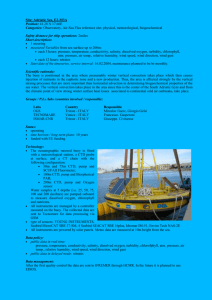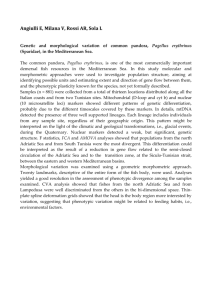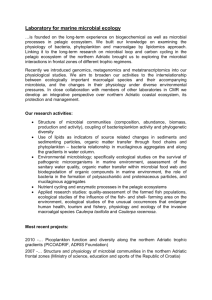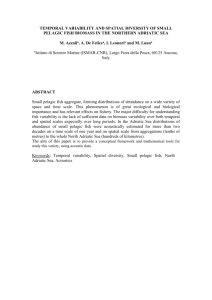A Connecting Sea- Maritime Interaction in Adriatic Prehistory
advertisement
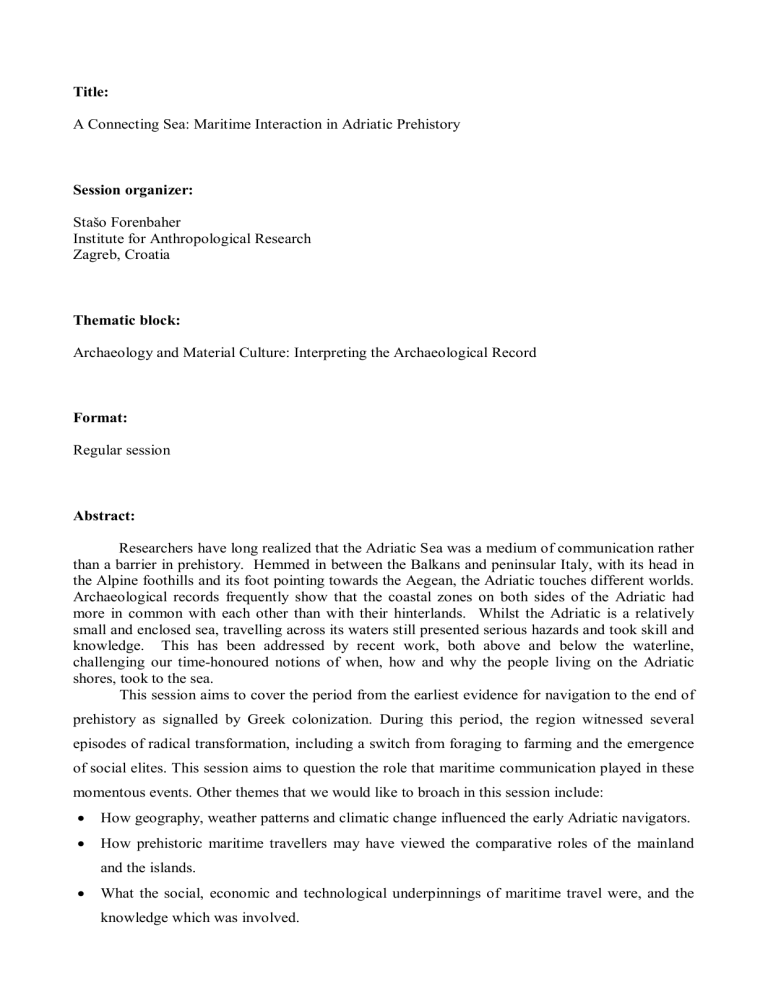
Title: A Connecting Sea: Maritime Interaction in Adriatic Prehistory Session organizer: Stašo Forenbaher Institute for Anthropological Research Zagreb, Croatia Thematic block: Archaeology and Material Culture: Interpreting the Archaeological Record Format: Regular session Abstract: Researchers have long realized that the Adriatic Sea was a medium of communication rather than a barrier in prehistory. Hemmed in between the Balkans and peninsular Italy, with its head in the Alpine foothills and its foot pointing towards the Aegean, the Adriatic touches different worlds. Archaeological records frequently show that the coastal zones on both sides of the Adriatic had more in common with each other than with their hinterlands. Whilst the Adriatic is a relatively small and enclosed sea, travelling across its waters still presented serious hazards and took skill and knowledge. This has been addressed by recent work, both above and below the waterline, challenging our time­honoured notions of when, how and why the people living on the Adriatic shores, took to the sea. This session aims to cover the period from the earliest evidence for navigation to the end of prehistory as signalled by Greek colonization. During this period, the region witnessed several episodes of radical transformation, including a switch from foraging to farming and the emergence of social elites. This session aims to question the role that maritime communication played in these momentous events. Other themes that we would like to broach in this session include: · How geography, weather patterns and climatic change influenced the early Adriatic navigators. · How prehistoric maritime travellers may have viewed the comparative roles of the mainland and the islands. · What the social, economic and technological underpinnings of maritime travel were, and the knowledge which was involved. · Who was travelling across the Adriatic and why they initially decided to travel across water. · How distributions of raw materials and pottery styles may inform us about maritime travel and how this changed over time resulting in the cultural diversity and coherence that characterized this region throughout most of prehistory. · Finally, how the situation in the prehistoric Adriatic compares to other parts of the Mediterranean, and to other inner seas elsewhere. Participants will offer new insights relevant to some of these questions, augmented by the results of recent fieldwork and current theoretical developments. (1) Beginnings of Trans­Adriatic Navigation: A View from Vela Cave Dinko Radić Navigation in southeastern Europe begins immediately after the end of the Glacial period (some 10.000 BP), when, due to global warming, the sea level rose for almost a hundred meters. The earliest of the ancient sailors navigated throughout the Mediterranean, but here our attention is primarily focused on connections between Apulia and Dalmatia. The main reasons for sailing in those days were search for sources of raw materials, exogamous marriage partners, and mutual reciprocities of technology and various experiences. Appearance and the construction of the primary navigational means represent an interesting problem. Studies are at the very beginning, so it is incomparably easier to establish connections between destinations (for example Cyprus and Palestine, Melos and Peloponnese, the islands of Palagruža and Korčula) than to grasp the construction of the ancient vessels, remains of which have not been preserved. (2) Changes in Seafaring and Use of the Sea during Neolithic: A View from Istria Darko Komšo Although the tradition of excavating Neolithic in Istria is older than 50 years now, only the recent excavations yielded data connected with seafaring and use of the sea. Kargadur is a Neolithic site located on the south­eastern coast of Istria. It consists of 2 phases, the Early Neolithic characterized by impressed ware, and Middle Neolithic characterized by the “Danilo” pottery. The difference between the phases is not just based on stylistic characteristics of pottery decoration, but also in the changes in subsistence strategies. One of the striking differences is the change in the perception and the use of the sea. During the Early Neolithic phase of the settlement, the use of local resources was predominant. The sea use was confined to food collecting and fishing, which is evident from the abundant seashell and fish remains, as well as several bone hooks. During the Middle Neolithic phase of the settlement, situation changed drastically. The sea was still used as the food resource, but the presence of exotic material, such as obsidian, exogenous flint and polished axes suggest the exchange through seafaring with the distant areas. (3) Procurement of Raw Materials for Lithic Artefacts in the Prehistory of Middle Dalmatia Zlatko Perhoč Topics of this research project are: (1) provenance of the raw materials for lithic artefacts, that were produced at the archaeological sites within the region under study; (2) sourcing and transport of the raw material; (3) question of provenance of the imported lithic artefacts. The project principally refers to chert and its varieties. Numerous outcrops of the siliceous sediment in the region are investigated. The petrographical spectrum of lithic artefacts in the region indicates diverse geographical origin of the raw material and different ways of its procurement and transporation. The aim of this research is to correlate archaeological sites and rock deposits within and outside of the studied region. Archaeometrical methods and techniques are used in the analysis of raw material provenance. (4) Around and Across the Adriatic: Obsidian Trade from the Tyrrhenian to Trieste Robert H. Tykot While early maritime travel in the Mediterranean has been demonstrated by the discovery of Melos obsidian in Upper Paleolithic contexts at Franchthi Cave, and the presence of Mesolithic settlements on at least a few of the larger islands, details about prehistoric seagoing are lacking, especially around and across the Adriatic. In the central Mediterranean, obsidian sources and trade have been well documented for the Tyrrhenian, in part because of the large number of excavated sites where lithic assemblages have been found and studied, especially in Sardinia, Corsica, Sicily, and mainland Italy. But it is only in recent times that obsidian artifacts found at sites along the Adriatic, especially on the eastern shores and on islands such as Susac and Palagruza, have been studied. Chemical analysis demonstrates that the vast majority of obsidian found along the Adriatic came from Lipari, while at inland sites in peninsular Italy a mixture of obsidian sources are represented. This paper specifically addresses the quantity and regularity of Neolithic obsidian trade and distribution around and across the Adriatic, and how it changed over this 3000 year period, with comparisons to other exchanged materials including ceramics and domesticated animals, and suggestions regarding perishable but socioeconomically significant material. (5) Figulina Ware as a Marker of Economic Change in the mid­6th Millennium BC? New Data on Figulina Pottery Production from the Middle Adriatic Michela Spataro Archaeologists have always seen figulina ware as a prestige item, with striking differences in texture and decoration compared to contemporary everyday pottery. It appeared along both Adriatic coastlines towards the end of the Early Neolithic, and was produced for more than a millennium, throughout the Middle Neolithic. To reinforce the idea that this special type of pot was a prestige/status item, some figulina pots have been found together with other exotic finds, such as Spondylus beads (e.g. at La Vela di Trento). In the last few years, figulina samples from Impressed Ware sites on both Adriatic coasts, and also from Danilo and Hvar sites in Croatia and recently from a Square­Mouthed Pottery site in Italy, have been analysed scientifically using thin­sectioning, Scanning Electron Microscopy­ Energy Dispersive Spectrometry and X­Ray Fluorescence. The analyses show that the figulina ware was made by a more sophisticated method than that used for the ordinary ceramics produced at these sites. The use of local clay sources to manufacture figulina ware shows that this technology was widely dispersed, although practised by a few specialist artisans. (6) Adriatic Offshore Islands and Long­Distance Interaction in Prehistory Stašo Forenbaher This presentation explores the proposition that the archaeological record of small, remote islands with scarce resources reflects the intensity of long­distance interaction in prehistory, taking as an example the Adriatic offshore islands. The best represented periods, the early Neolithic and the end of the Copper Age, correspond to the times of large­scale stylistic unity, the former, of the Mediterranean Impressed Wares, and the latter, of the Bell Beakers. During those periods, radical innovations were introduced over vast areas of Europe, first, a new subsistence economy, and second, a different kind of social organization. In both cases, long­distance interaction would have played a crucial role. (7) Down to the Sea in Boats: Navigational and Technological Constraints on Adriatic Sailors of the Copper Age. Timothy Kaiser The sea does not permit sailors to travel across its expanse without constraint. Winds and currents sometimes permit maritime traffic and at other times they prevent it. Discovering when and where optimal (or even just tolerable) conditions obtained would have been a particular challenge to prehistoric sailors navigating the Adriatic. Refining that knowledge and disseminating it must also have been crucial to the successful maintenance of long­distance overseas interactions. Such interactions appear to have been exceptionally important at several prehistoric junctures, notably the Copper Age. This paper considers how navigational considerations, environmental and technological, may have affected the development of Copper Age networks in the eastern Adriatic. (8) What is Moving and What is Not: Archaeological Evidence of Human Mobility on the Shores of the Adriatic between Copper and Bronze Age Franco Nicolis Since few years isotopic analyses have shown that people moved around all over Europe in late prehistory. Archaeological reasoning is traditionally based on the evolution of the cultural setting, but “cultures don’t migrate, people do” (D. Anthony). In this paper, a discussion of how archaeological evidence can explain the human mobility in absence of analytical studies on human remains will be presented. The Adriatic sea, like the Alps, has never been a natural barrier. There is good evidence of long distance interrelations between the two shores of the Adriatic, and beyond, in the mid/late 3rd millennium BC, probably connected with the more complex phenomenon of the Bell Beaker. What does this mean? Displacement of people or dissemination of ideas? But “ideas don’t migrate, people do”. And why people were on the move? Was the long distance travel “an anonymous by­product of the economic system” (F. Kvalo) or did it have an ideological and political significance (M. Helms)? (9) Seafarers and Land Travellers in the Bronze Age of northern Adriatic Elisabetta Borgna & Paola Cassola Guida According to several contributions the Adriatic regions would have been involved not only in coast­to coast contacts but also in the network of long­distance relationships that had linked Western Anatolia, the Aegean islands, Greece and the central Mediterranean in the Early Bronze Age (with reference to the Eastern and Aegean chronology). Did small scale connections on a local level create the framework for a highly directional organized exchange? Or were long­distance exchange activities responsible for the increase in local mobility and tramping? In the paper the evidence for sea travelling is analysed taking into particular consideration the function of monumental architecture in the making of coastal landscapes consistent with sea­faring. Also inland monumental landscapes, such as the setting of EBA burial tumuli in Friuli and Venezia Giulia, Northern Adriatic, may be considered in the perspective of Adriatic mobility, as they seem to reveal a link ­ both conceptual and cultural ­ with the monumental seascapes. (10) Prehistoric Occupation of the Albanian Adriatic Coast Ols Lafe & Michael L. Galaty In this paper we investigate patterns of settlement along the Adriatic littoral of Albania, which varied in intensity during different periods of prehistory. We apply a “coastscape” model, as developed by Pullen and Tartaron to explain occupation of the Saronic Gulf coast of the Aegean Sea in Greece. In Albania, settlements on the coastal plain were strongly tied to settlements located in their interior, mountainous hinterlands. These relationships were largely economic, related to Adriatic trade. This can be contrasted to other Adriatic and Aegean “coastscapes”, where the relationships between coastal and interior sites were defined politically, as well. (11) An Overview of Prehistoric Settlement Topography and Maritime Connections on Lastovo Island, Croatia Bryon Bass, Philippe Della Casa, Branko Kirigin, Dinko Radić, & Tea Katunarić The Augusta Insula Project focuses on the Croatian island of Lastovo. These investigations are part of ongoing archaeological and interdisciplinary research in the southern Dalmatian archipelago conducted under the aegis of the Korčula Archaeological Research Group (KARG). The multinational team for the 2001, 2003, and 2007 field campaigns consisted of archaeologists and geologists from Croatia, Switzerland, the United States, and the United Kingdom. Field studies focus on the application of heritage management practices pertinent to the island’s archaeological and historical resources. The first season’s research consisted of preliminary bibliographic studies and field survey, while the second field season consisted of limited subsurface archaeological testing at the localities of Kaštel and Lučica. The third season focused on more intensive field survey, informant interviews, and data collection. A GIS data base has been developed to examine the inter­relationships of the sites, and their relationships to the regional prehistoric and protohistoric coastal marine setting. The project is similar in scope to the Adriatic Island Project. Eventually, a joint data­base (including Sušac and Pelješac Peninsula) will enable the study of a large group of islands. Such a common data collection approach would be unique to Mediterranean archaeological research.
